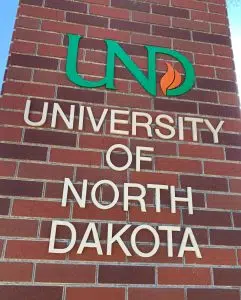
A new grant to UND Aerospace from the Federal Aviation Administration will connect high school teachers throughout the state with flight, drones and North Dakota’s aviation industry.
The $500,000 grant, an 18-month workforce development effort, aims to engage STEM teachers by giving them the tools and means by which to teach students about careers in aviation, as well as provide hands-on flight experiences in the classroom.
“We are enthusiastic to be a part of the FAA Aviation Workforce Development grant program,” said Elizabeth Bjerke, associate dean of the John D. Odegard School of Aerospace Sciences. “This award will help us reach across the entire state of North Dakota to raise excitement and interest in aviation-related careers. We can’t wait to get started!”
“We also would like to thank North Dakota Sens. John Hoeven and Kevin Cramer for their instrumental efforts in securing funding for these grants,” Bjerke added.
Paul Snyder, director for UND’s UAS Program and co-lead on the project, shared in that excitement, saying that North Dakota is a great place for students to learn and seek opportunities in aviation careers. Also involved in the project with UND Aerospace are the North Dakota Aeronautics Commission, the North Dakota Aviation Association and UND’s College of Education & Human Development.
“This is an inspiring opportunity, with so much change happening in our industry, to engage students and put the possibilities of a career in the palm of their hand,” Snyder said. “When I came to UND, all I knew about was commercial flight. But there’s a lot more you can do.”
Snyder and principal investigator Leslie Martin, associate professor of aviation, plan to use small drones as a platform for teaching STEM teachers about unmanned aircraft systems, commercial aviation and the real-world applications for traditional aircraft and UAS technologies.
“Since the FAA has identified future shortages for specialized aviation careers, we need to talk to students early to show them what those pathways are,” Snyder said. “Our plan is to get hands-on learning experiences to students, to help introduce them to some really interesting careers.”
Teaching the teachers
According to the FAA, UND Aerospace faculty will host eight “Teach the Teacher” events across the state, which will take the form of professional development workshops for teachers.
The workshops will involve online training, which will guide teachers through baseline UAS certifications, as well as in-person sessions to both fly drones and go over aviation lesson plans that teachers can tie into already-existing STEM curricula.
Martin, a professor with high school teaching experience, said her group also wants to show teachers immediate examples of the aviation industry at work in North Dakota. Though UAS is a cost-effective and user-friendly introduction to aviation, she said, the sessions will deal with all realms of flight – manned and unmanned.
“We’re planning on delivering teaching aids, and things for teachers to bring into the classroom, but we also want to take them on field trips to Cirrus Aircraft, for example, to show them the engineering behind everything,” Martin said. “Then we’ll go to Northrop Grumman and General Atomics to show what’s happening in the unmanned space.”
The possibilities for real-world exposure are numerous, Martin said, between visiting such companies as well as touring airport facilities, airline offices and perhaps even Air Force bases in the region.
Another piece behind the teacher outreach is creating a website with resources, frequently asked questions and means by which to maintain contact between UND faculty and STEM teachers statewide, Martin said. One resource that has already been developed is the Aviation High School Facilitator Guide, a curriculum guide written by both Martin and Snyder, as well as Sarah Anderson and Brittany Hagen of Mayville State University.
“There are educated, smart STEM teachers in our state’s schools, and we created something that can help them use their educational background to teach aviation,” Snyder said. “What the book provides is a one-year aviation curriculum with a companion student notebook containing activities and assignments. It’s something that expands on what we’re trying to do through this grant work.”
Career gateways
Another major component of reaching North Dakota’s schools through aviation will be providing schools with a limited number of drone racing kits. Martin said it’s a way to have teachers leave the professional development sessions with something tangible, including the FAA Part 107 certification to fly small drones.
“We want to spend a day with teachers, teaching them to fly drones and how they work, but we also want to show them what drone racing is like,” Martin said. “We think it’s something that can be brought back to classes and used to develop new student organizations.”
Much in the way robotics and esports are extracurricular endeavors in high schools, drone racing is a similar activity that can elevate students’ enthusiasm into aspirational pursuits, whether in piloting, engineering or computer sciences.
“Drones represent an area of significant growth for the aviation industry into the future, so we want to find ways to expose students to already existing jobs and careers on the horizon as we see UAS used in a variety of industries and sciences,” Martin said.
“I think the possibilities are wide open for teachers in how they incorporate this diverse topic,” Martin added. “Our hope is that this grant will provide some inspiration, in that regard.”
(UND release)










